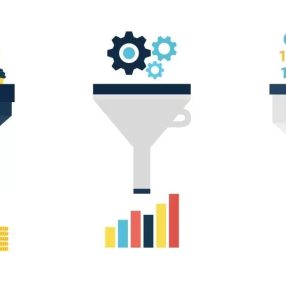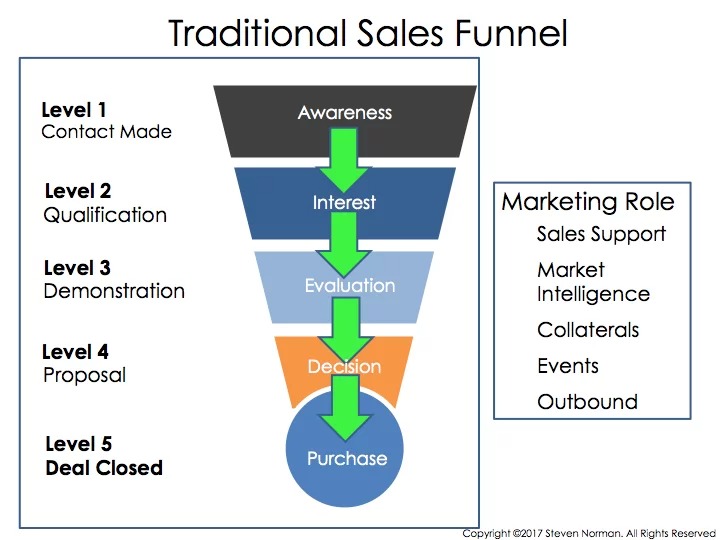
The Revolution of the Sales Funnel
The Rapid Evolution from Sales Funnel to Customer Journey
There has been a huge change in the behaviour of the B2B buyer over the last ten years or so. Previously, a buyer would have been taken out for lunch, to the golf course or cold-called by a salesperson. Today, professional buyers are conducting between 70-80% of their buying journey without ever making contact with a single salesperson.
With so many sources of information for product research, reviews and references, customers no longer need a salesperson until the final stages of the buying process. And, by then, it can be too late for a salesperson to influence their direction.
Buyers are much more in control
The shift has been dramatic and fast. When it comes to B2B sales, business leaders find themselves playing catch-up and having to adapt to a sales environment that looks vastly different from the traditional process that prevailed before.
And if they don’t adapt or aren’t open to adapting, they could lose out. I’ve met some sales leaders that don’t realise what’s happening to them. They are suffering from poor results but blame it on a slow market or on their team without realising the fundamental shift that’s going on. At the Enterprise level with its long sales cycles, the loss can be slow at first as customers see out their contracts but it will then be a rush as more nimble competitors become top-of-mind for buyers. The non-adaptors won’t even see the problem until it’s too late.
And then they’ll wonder what the hell went wrong.
What to do?
It’s imperative that we make a major effort towards presenting ourselves as leaders in our field and influencing the buyer early on in their buying process and we must pay significant attention to the customer after they buy. Notice that I said ‘their’ process, as the customer is now much more in control of the process, rather than it being a sales-driven process – we now talk about the ‘customer journey’. Of course, this is where marketing comes in and having a strong B2B marketing function, closely integrated with sales, is critical to success.
The good news is that when this is implemented well, we will get well-qualified leads and have prospects that are warm towards a sales approach. They are likely to be positive about your company and your solution, therefore your ‘close’ rates and sales productivity should be much better.
So, what do the two sales processes look like – the traditional versus new approaches?
The long-standing traditional sales process
The traditional B2B sales process and funnel looks something like the diagram below, which I’m sure you recognise and have worked with some version of this.

It’s important to note the following key points when it comes to this model:
- It is sales-driven. Territories are handed out to salespeople and it is then their responsibility to drive the process. They actively made contact with prospects, find opportunities, qualify them and then drive opportunities through the funnel until deals are closed.
- Marketing has a supporting role. The role of marketing here is very much to support the sales team with training, some general market and competitive intelligence, sales collaterals and outbound marketing activities such as email blasts and direct mail, plus support with events and so on.
The ‘NEW’ Sales/Marketing funnel
Many organisations I meet with are wholly down the path (or somewhere along it) to accommodating the new buying process and are trying to get themselves in front of buyers in the early stages of their research.
Here’s my view of what the ‘new’ sales/marketing funnel looks like.

There are some critical points of difference from the traditional model, as follows:
- This funnel is modelled around the customer journey, rather than from the selling organisation’s point of view or process.
- Marketing has a much bigger role to play. This is especially so in the early stages of the customer journey. We want to be prominent and present ourselves as credible when the customer does their first Google search. We then want to engage them with interesting and relevant content, have them download white papers or join a webinar, the lead-nurturing process.
- Sales is more focused on the critical selling functions lower in the funnel, they still do some well-qualified prospecting work but should spend most of their time working on active deals.
- Intelligence is much deeper and specific than previously. We must understand our customers and the ideal customer profiles (ICPs), plus what their specific buying journey looks like. Ideally, we want to have data down to the industry and account level, and execute on Account Based Marketing (ABM). This vastly improves the productivity of our sales prospecting efforts and close rates.
- Content and marketing vehicles are chosen to specifically target these decision makers when they are doing their buying research.
- The sales and marketing functions are much more integrated and often under the same leader. Regardless of reporting, a close working relationship between the functions and at all levels is critical.
- Achieving a sale is not the end point of the process but a meaningful milestone on the way to turning the customer into a true advocate. We want to turn that first purchase into a long-term satisfied customer. Therefore, there will be a range of proactive loyalty, retention and cross-selling activities directed towards new and existing customers.
- Our ultimate goal job is for our customers to become an active advocate for our company and the value of our solution. This then becomes a powerful lead generator and a point of reference for winning more new customers.
Running business the old way, along traditional sales lines, still conjures up images of the old sales boiler room, where sales leaders ‘drive’ their teams relentlessly to make targets and ‘push’ products to customers. This approach is just too one dimensional and blunt for today’s environment. Yes, we still need to be aggressive to make our targets but let’s be aggressive on driving the range of activities that assist customers to understand our value all the way along their buying journey.
Customer-centricity and CX (Customer Experience) are the buzzwords of the moment, and there’s a reason for this. The new sales/marketing funnel is a sign of the changing times and it works. The question is: are you a new adopter or yet to change?
Let me know in the comments below and let’s open this up for discussion.
If you’d like to learn more about the new sales/marketing funnel, get in touch with me at [email protected]. I’d be more than happy to have a short introductory discussion to run through the model in more detail and also assess where we might be able to support you.



